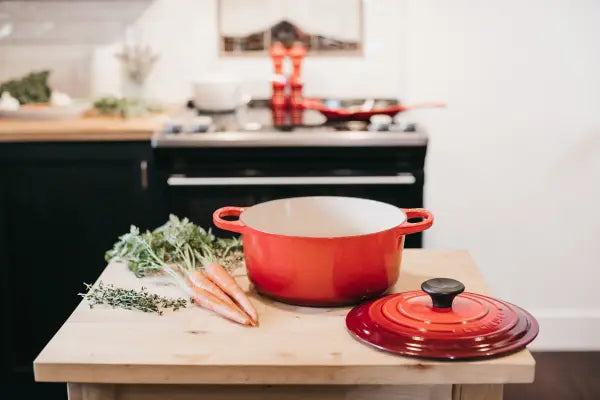Baby Food Safety Guidelines Every Parent Needs to Know

When you are feeding your baby, it is not just about choosing the right foods, it is also about handling those foods safely. Babies' immune systems are still developing, which makes them more vulnerable to foodborne illnesses like Salmonella, Listeria, and E. coli.
The good news? A few simple kitchen habits can dramatically reduce the risk.
Let’s walk through the essentials, step by step!
Why babies are more vulnerable to foodborne illness
- Babies' immune systems are immature and still developing. They are slower and less efficient at recognizing and eliminating harmful bacteria, viruses, and toxins from contaminated food.
- Babies have less acidic stomach environments, especially in the first 6-12 months, making it easier for bacteria like Salmonella or Listeria to survive and cause infections. In adults, strong stomach acid helps kill off many harmful bacteria before they can cause problems.
- Their smaller size means illnesses that cause vomiting or diarrhea can lead to dehydration really quickly!
- The gut microbiome (the healthy bacteria living in the intestines) plays a key role in defending against infections.
How to safely prep baby food in your own kitchen

1. Wash your hands: the smallest step that makes a big difference
Wash your hands before, during, and after food prep.
Wash hands after touching:
-
Raw meat
-
Eggs
-
Phones (surprising but really gross!)
-
Pets
-
Diapers
2. Clean surfaces to prevent cross-contamination
-
Wipe counters and high chairs with hot, soapy water or a disinfectant spray.
-
Use separate cutting boards for raw meats and fresh produce.
3. Wash fruits and vegetables before cutting or peeling
-
Rinse all fruits and veggies under running water—even if peeling them.
-
Scrub firm produce (carrots, sweet potatoes) with a clean brush.
The “Dirty Dozen”: produce to wash with extra care
The Environmental Working Group (EWG) publishes a list of fruits and veggies with the highest pesticide residues, called the Dirty Dozen.
For these foods, buy organic if possible, and wash them extra carefully. The full list and yearly updates are available at EWG Dirty Dozen. Here are a few of the most common ones:
-
Strawberries
-
Spinach
-
Kale, collard, mustard greens
-
Peaches
-
Pears
-
Nectarines
-
Apples
-
Grapes
-
Bell and hot peppers
-
Cherries
-
Blueberries
-
Green beans
💡 There’s also a Clean 15 list, which have the least pesticide residues, making them safer options in non-organic form if needed.
4. Rinse rice to reduce arsenic exposure in babies
-
Rinse rice thoroughly under cold water before cooking, swishing it around with your fingers, and continue until the water runs clear—usually 4–5 rinses.
-
Rice tends to contain higher levels of inorganic arsenic compared to other grains because rice plants absorb it from soil and water more readily.
-
Basmati rice and sushi rice tend to have lower arsenic levels compared to brown rice.
-
Rice is still a great first food—but vary the grains you're offering such as oats, quinoa, millet, and barley to reduce overall exposure.
5. Keep raw foods separate
Simple fridge strategies to avoid cross-contamination:
-
Store raw meats in sealed containers on the bottom shelf of the fridge.
-
Keep fresh produce above meats to avoid drips.
Chopping meat and fruit? Here’s how to keep things safe:
Use different utensils and boards for meat and produce to prevent cross-contamination.
How to cook, store, and reheat baby food without the guesswork

Three easy defrosting methods (and one to skip entirely)
Thaw frozen foods:
-
In the refrigerator (best)
-
In cold water (change water every 30 minutes)
-
In the microwave (if cooking immediately after)
Never thaw food on the countertop!
A quick guide to safe cooking temps for baby meals
Cook foods to safe internal temperatures:
-
Chicken, turkey: 165°F (74°C)
-
Ground beef, pork, lamb: 160°F (71°C)
-
Fish: 145°F (63°C)
Use a food thermometer to double-check.
Fridge, freezer, or toss? How long baby food actually lasts
Cool cooked food quickly (within 2 hours or less). You can use shallow containers to speed up cooling and refrigerate food immediately after cooling.
Storage times:
-
Refrigerated homemade baby food: up to 3 days
-
Frozen baby food: best within 1–3 months
Always label containers with the prep date and contents for easy tracking. Store in small portions separately so you only defrost what you need.
Reheating baby food: how hot is hot enough—and then cool enough
-
Reheat food until steaming hot (165°F).
-
Stir thoroughly after microwaving to avoid hot spots.
-
Allow food to cool to a safe serving temperature before offering it to your baby.
-
Do not reheat the same food more than once.
Find safe fridge/freezer storage guidelines on the CDC’s food safety page.
How to handle breast milk, formula, and early feeding staples

Breast milk storage and safety tips
Whether you’re pumping occasionally or storing milk regularly, keeping breast milk safe doesn’t have to be complicated. These simple storage guidelines can help preserve nutrients and reduce the risk of bacteria—so you can feel confident about what you’re offering your baby (even when feeding looks a little different day to day).
Freshly expressed:
-
Room temp: Up to 4 hours
-
Fridge: Up to 4 days
-
Freezer: 6–12 months
Thawed milk:
-
Use within 24 hours
-
Never refreeze
Warming milk:
Warm milk by placing the bottle in warm water.
Do not microwave breast milk—this can cause uneven heating and destroy nutrients.
👉 More info: CDC Breast Milk Handling
Formula safety made simple (just follow the label, really)
Formula can be a nourishing and safe choice when prepared and stored with care. The good news? You don’t need to overthink it. A few simple steps—like paying attention to timing and storage—go a long way in keeping your baby’s bottle safe and ready.
Prepare formula exactly as instructed on the package.
Use prepared formula:
-
Within 2 hours if left at room temperature
-
Within 24 hours if stored in the fridge
🚨 Discard formula if:
-
Baby started drinking from the bottle over 1 hour ago
A few foods to pause on until baby’s first birthday
Some foods are best saved for later—not because you’re doing anything wrong, but because babies’ digestive and immune systems are still developing. See below for a quick list of common foods to avoid for now.
Want to dive deeper? Here’s a closer look at why these foods are better skipped (for now).
Why honey and unpasteurized foods aren’t baby-friendly yet
-
Honey: Risk of infant botulism. No honey before 12 months.
-
Unpasteurized dairy or juices: Avoid due to bacteria risk.
Choking hazards to be aware of—plus how to serve them more safely
-
Whole grapes ➝ Slice into quarters
-
Peanut butter ➝ Thinly spread or mix into other foods
-
Raw hard veggies ➝ Cook until soft
Final baby food safety guidelines to remember
Safe food handling doesn’t have to be overwhelming.
Think of it as a few simple habits:
-
Wash everything (hands, surfaces, foods)
-
Cook foods thoroughly
-
Store foods properly
-
Stay alert to high-risk foods
Your pediatrician, trusted resources like Bebe Foodie, the American Academy of Pediatrics, and agencies like the CDC are all here to support you along the way.
Safe eating results in healthy, happy babies—and in turn, less stressed parents!

Written by Dr. Michelle Shiffman, MD
Pediatrician & Advisor at Bébé Foodie
Dr. Michelle Shiffman is a board-certified pediatrician based in Denver, Colorado. She brings her expertise in early development, food introduction, and culturally-sensitive care to Bébé Foodie, where she supports the creation of our evidence-based content and contributes to our expert panel. Michelle’s favorite part of her work is connecting with families during infant and toddler visits—especially when it comes to discussing developmental milestones and feeding. As a mom herself, she's also experienced the ups and downs of starting solids and managing picky eating.



